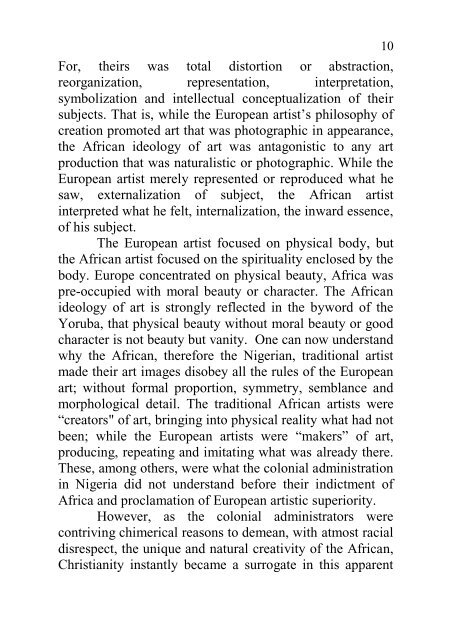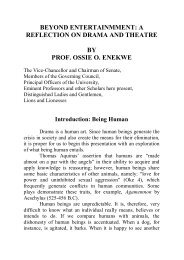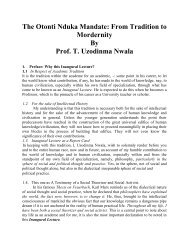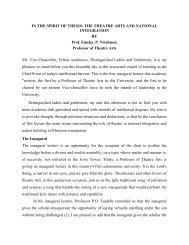visual arts in an artistically uninformed nigerian society
visual arts in an artistically uninformed nigerian society
visual arts in an artistically uninformed nigerian society
You also want an ePaper? Increase the reach of your titles
YUMPU automatically turns print PDFs into web optimized ePapers that Google loves.
10<br />
For, theirs was total distortion or abstraction,<br />
reorg<strong>an</strong>ization, representation, <strong>in</strong>terpretation,<br />
symbolization <strong>an</strong>d <strong>in</strong>tellectual conceptualization of their<br />
subjects. That is, while the Europe<strong>an</strong> artist’s philosophy of<br />
creation promoted art that was photographic <strong>in</strong> appear<strong>an</strong>ce,<br />
the Afric<strong>an</strong> ideology of art was <strong>an</strong>tagonistic to <strong>an</strong>y art<br />
production that was naturalistic or photographic. While the<br />
Europe<strong>an</strong> artist merely represented or reproduced what he<br />
saw, externalization of subject, the Afric<strong>an</strong> artist<br />
<strong>in</strong>terpreted what he felt, <strong>in</strong>ternalization, the <strong>in</strong>ward essence,<br />
of his subject.<br />
The Europe<strong>an</strong> artist focused on physical body, but<br />
the Afric<strong>an</strong> artist focused on the spirituality enclosed by the<br />
body. Europe concentrated on physical beauty, Africa was<br />
pre-occupied with moral beauty or character. The Afric<strong>an</strong><br />
ideology of art is strongly reflected <strong>in</strong> the byword of the<br />
Yoruba, that physical beauty without moral beauty or good<br />
character is not beauty but v<strong>an</strong>ity. One c<strong>an</strong> now underst<strong>an</strong>d<br />
why the Afric<strong>an</strong>, therefore the Nigeri<strong>an</strong>, traditional artist<br />
made their art images disobey all the rules of the Europe<strong>an</strong><br />
art; without formal proportion, symmetry, sembl<strong>an</strong>ce <strong>an</strong>d<br />
morphological detail. The traditional Afric<strong>an</strong> artists were<br />
“creators" of art, br<strong>in</strong>g<strong>in</strong>g <strong>in</strong>to physical reality what had not<br />
been; while the Europe<strong>an</strong> artists were “makers” of art,<br />
produc<strong>in</strong>g, repeat<strong>in</strong>g <strong>an</strong>d imitat<strong>in</strong>g what was already there.<br />
These, among others, were what the colonial adm<strong>in</strong>istration<br />
<strong>in</strong> Nigeria did not underst<strong>an</strong>d before their <strong>in</strong>dictment of<br />
Africa <strong>an</strong>d proclamation of Europe<strong>an</strong> artistic superiority.<br />
However, as the colonial adm<strong>in</strong>istrators were<br />
contriv<strong>in</strong>g chimerical reasons to deme<strong>an</strong>, with atmost racial<br />
disrespect, the unique <strong>an</strong>d natural creativity of the Afric<strong>an</strong>,<br />
Christi<strong>an</strong>ity <strong>in</strong>st<strong>an</strong>tly became a surrogate <strong>in</strong> this apparent







